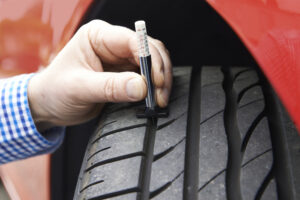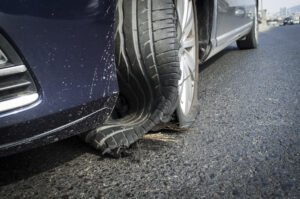Tire maintenance is one of the simplest & fastest car care tasks that help keep vehicles & families safe on the road
With the summer weather upon us and some easing of restrictions, many Canadians are considering getting away…to anywhere really, at this point. Whether it’s seeing family, visiting a friend, or even just getting out of town, summer plans likely include taking a road trip. Or, maybe thanks to last summer’s unexpected opportunity to dabble in planting that vegetable garden you always wanted, you’re now seeing the fruits (or, vegetables as the case may be) of your labours showing signs of life after the long winter. So, now it’s time to get back to the garden centre because your green thumb hobby became your latest passion. No matter your activity of choice, ensuring your vehicle and trailer tires are up to the task is essential to help keep yourself and our roadways safe.
Remember when…
We all have an early childhood memory of a family road trip and seeing a vehicle at the side of the road with fellow travellers struggling to change a tire. This typically involved digging out the jack along with that teeny tiny spare and hoping to make it to the closest gas station. Of course, Murphy’s Law dictated this either happened on a deserted road or a busy highway where the driver had to watch their back for lane drifters while re-evaluating their choice not to pay for roadside assistance. You probably also remember driving past and whispering a word of thanks that it wasn’t your vehicle that blew a tire, or maybe you were one of the precious few who actually stopped to lend a hand. With this image fresh in your memory, it’s important to make a plan before you hit the road to ensure your routine run for supplies or next big adventure goes smoothly.
According to a recent survey by the Tire and Rubber Association of Canada (TRAC), “61 percent of drivers are planning a summer road trip or a drive to a vacation destination. Among younger drivers aged 18 to 34 and 35 to 44, that number climbs to 70 per cent and 72 per cent respectively.”
And, if your summer plans include adding that old utility trailer or camper newly uncovered from a deep layer of snow, do more than simply assure yourself it’s still in good shape. Take the time to really assess its road worthiness before hooking it up to your vehicle and driving off, particularly if you’re planning to transport heavy items, such as a washer/dryer, fresh sod, or that borrowed riding mower. No one wants to feel the sudden lurch of their vehicle pulling a fully loaded trailer and worry one of the trailer’s poor old tires can’t take the pressure. We can all agree driving your vehicle with that trailer or camper in tow on a highway is not the time to realize your tires aren’t going to make it because they don’t have adequate tread or pressure to get you home safely.
Tip: Tires may well be the unsung heroes of vehicle safety, and tire maintenance is actually one of the simplest and fastest car care tasks that help keep vehicles and families safe on the road.
Properly maintained tires help vehicle safety systems do their job

It’s not really surprising studies show vehicle safety features can prevent crashes and injuries, especially when combined with safe driving practices. However, the majority of Canadian drivers are unfamiliar with newer, available safety features, how they work, and when they would be useful. One of the most common active safety features is ABS, designed to help drivers retain steering control by preventing wheels from locking up during an episode of heavy braking. But, what if the tread on those tires is worn, or the tire pressure isn’t correct?
Tire maintenance is one of the easiest and most important things to do to keep your vehicles in safe running order. If your tires are not in good working condition, e.g., your tires are significantly under- or over-inflated, your tire treads are worn below legal limits, or there is damage on the tire sidewall, the rest of your vehicle’s safety features such as ABS, ESC, and traction control will simply not be as effective. This can affect your control over the vehicle, as well as your fuel economy, ride comfort and tire life. Quite simply, these important safety features which require four fully functioning wheels aren’t as effective, or may not work altogether, if you don’t have decent tires.
Where the rubber meets the road regarding speed, distraction & tire pressure

So, assuming your tires have good tread and are at the correct pressure, at 130 km/h, you still need 150 metres to stop, which is longer than a football field. In other words, blowing a tire at this speed can be fatal.
According to a 2012 NHTSA study (Tire-Related Factors in the Pre-Crash Phase), when tires are underinflated by 25% or more, tires are three times as likely to be cited as critical events in the pre-crash phase. Also, NHTSA’s Be TireWise! Flyer reported that in 2017, drivers in the United States put more than 3.2 trillion miles on their tires. In that same year, there were 738 people killed in tire-related crashes.
The Tire and Rubber Association of Canada and their Be Tire Smart education initiative, are sharing these helpful tips to prepare tires to safely handle the pressures of this summer’s camping adventures. Or, maybe you’re tackling any number of DIY or home gardening projects with that old utility trailer not used in, well, forever.
Tire Maintenance Done Right:
Taking care of our tires is a choice that literally affects our safety and that of every other driver sharing the road with us. So, before you head out on your big adventure or hook up that camper or utility trailer, take a moment to check tire wear and pressure. Let’s make it a safe AND fun summer!
#MySafeRoadHome blog co-authors: Robyn Robertson, TIRF President & CEO, and Karen Bowman, Director, TIRF Drop It And Drive® (DIAD) program, worked collaboratively on this article. Robyn is the author of TIRF’s knowledge translation model, is well-versed in implementation strategies and operational practices across several sectors. Karen is also TIRF’s Director of Marketing & Communications; she uses her writing and blogging background to help apply TIRF’s research to real-world driving, cycling and walking.
Related topics:
 |
 |
 |
 |
Source documents and resources:
Road Trips to Surge in Pandemic’s Wake, Tire and Rubber Association of Canada, June 2021 https://tracanada.ca/news/road-trips-to-surge-in-pandemics-wake
Brain on Board – Your brain is your vehicle’s most important safety feature, Traffic Injury Research Foundation, brainonboard.ca – NEW MODERN DESIGN
You may actually be able to travel for summer vacation in Canada this year, CBC News, May 2021 https://www.cbc.ca/news/canada/summer-vacation-covid-19-travel-restrictions-1.6022536
Why Your Pandemic Garden Wasn’t Just a Panic Hobby, Better Homes & Gardens, Feb. 2021 https://www.bhg.com/gardening/gardening-trends/coronavirus-pandemic-garden
Choi, E-H. (2012, April). Tire-Related Factors in the Pre-Crash Phase. (Report No. DOT HS 811 617). Washington, DC: National Highway Traffic Safety Administration.
Be TireWise!, National Highway Traffic Safety Administration https://www.nhtsa.gov/sites/nhtsa.gov/files/documents/tirehome_eng.pdf
Is going 20 or 30 km/h above the speed limit a big deal?, The Globe and Mail, May 2021 https://www.theglobeandmail.com/drive/culture/article-is-going-20-or-30-kmh-above-the-speed-limit-a-big-deal
Distracted Driving Facts, Traffic Injury Research Foundation (Canadian Coalition on Distracted Driving), December 2017 http://tirf.ca/TIRFCAD17K


